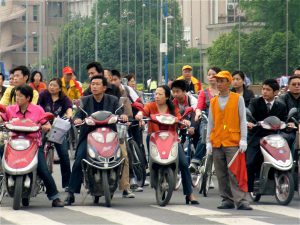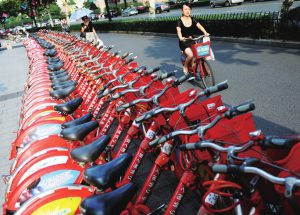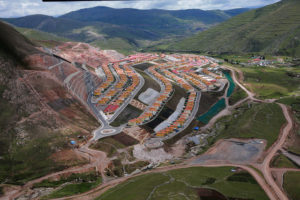As taxi driver Zhou pulls away from Chengdu North Railway Station, he looks back out the window at his colleagues, crowing: “The airport! I’ve got an airport one!”
It’s a rare success. Three long rows of taxis stand outside this rail station in the capital of Sichuan province, central China: there is no passenger queue. At Chengdu’s airport, taxi drivers can wait as long as three hours for a fare.
The licensed taxi drivers are suffering the twin effects of widespread uptake of taxi-hailing apps, such as Uber and Didi, and increased car ownership.
Worse air than Beijing
Taxi apps have been promoted by Uber as a possible route to cutting traffic jams and air pollution, but Chengdu’s experience suggests otherwise.
Chengdu’s congestion and pollution are acute, even compared to Beijing’s notorious gridlock and smog. Car numbers have soared in Chengdu (one of the most populous cities in southwest China and a major transport hub) since 2008, with increases averaging 20,000 a month since 2011. There are 4 million cars, for a population of 14.65 million, whereas Beijing has 5 million cars among 21.7 million people – and six ring roads to Chengdu’s three.
Research carried out by Peking University’s Statistical Science Centre and Guanghua School of Management found that Chengdu suffers from air pollution 88% of the time – even worse than Beijing at 76%. The average pollution incident there lasts 92.4 hours, compared with 67.9 hours in Beijing.
Located in the Sichuan basin, Chengdu has little wind and high humidity, so pollution is not easily dispersed. So far, there has been no detailed research on the causes of pollution in Chengdu.
See also: Pressure builds to fight smog in Western China
Road use research
However, a study has tried to understand the situation through real time traffic monitoring of urban areas. Private cars are fitted with detector devices to report data on how journeys are made in the city, congestion patterns, and levels of carbon emissions, in a search more sustainable forms of transport.
The study – done jointly with Uber – involved researchers from non-profit think-tank the Innovation Centre for Energy and Transportation (iCET), Southwest Jiaotong University in Chengdu, and the National Development and Reform Commission’s Energy Research Institute, beginning in 2015 and finishing at the end of 2016.
Nie Yuren of Uber’s Beijing Research Institute provided Uber data for the research. Uber says its carpooling service has helped avoid journeys totalling 50 million kilometres, or 14,000 tonnes of “carbon” (51,333 tonnes of carbon dioxide or CO2), since it opened in Chengdu in October 2014.
An initial analysis of real-time data gathered by independent car data found that private cars in the city centre produce 17,500 tonnes of carbon emissions every day – 59% higher than the conventional estimate, and close to half of total daily emissions for all transportation in New York in 2010.
Car pool option
Online taxi hailing was endorsed by Uber and iCET as one possible method for cutting vehicle emissions, by increasing the usage rate of cars and overall transportation efficiency.
An analysis of the real-time monitoring data showed that 80% of journeys in Chengdu overlapped, having a similar origin and destination. iCET used the data gathered to model emissions under a car pooling scenario, finding that if passenger loads and vehicle use increased by 60%, congestion in the city would be significantly reduced and transportation emissions would fall by 70%.
Uber-crowded
However, drivers may be making more journeys thanks to taxi apps. Officials believe there are now more private car owners working as occasional drivers for taxi-hailing apps Uber and Didi (Uber’s most popular Chinese rival) than there are licensed taxis, though there are no statistics.
Didi was founded in 2012 and quickly dominated its Chinese rivals. In 2015, it launched a new service allowing private car owners to act as taxis, which it trialled in Chengdu, bringing it into competition with Uber, which had arrived there in October 2014.
According to a smart transportation report published early this year, Didi’s Chengdu users made an average of 5.3 journeys a month in 2015, more than in any other Chinese city.
Barriers to becoming a Didi driver are low; a driving licence held for a year, and a car less than five-years old and with a base price of at least 50,000 yuan (US$7,477) and a local licence plate. Guaranteed minimum fares, and bonus payments – such as 300 yuan for new drivers after 10 journeys – have encouraged car owners to sign up.
Uber’s requirements are tougher, but subsidies are higher and passengers get bonuses, too.
Extra journeys
Now private cars that would previously have been driven straight home after work are spending two or three hours carrying people around the city, and owners may even nip out and do a couple of quick fares when they have some spare time. Drivers from surrounding county towns are also coming in to the city to get in on the act.
Taxi drivers’ have halved over the last two years due to competition and traffic jams, forcing some to work for app-based companies instead. Zhou said: “They’ve bought their own cars and installed Didi.” Very few of the vehicles are electric or hybrid (which in China usually involves a coal-based grid to recharge batteries) while poor standards of fuels exacerbate the impact of cars on air quality in Chinese cities.
The best hope for cutting congestion and pollution may be plugging the shortfall in public transport. Much of Chengdu’s subway mass transit system is new, with many new lines planned.
The National Development and Reform Commission has approved a new round of subway construction, which will see the existing, or under-construction Lines 1, 2, 3 and 4 supplemented with extensions to both Line 1 and 3. This will give the city 291 kilometres of subway lines, with rail transport accounting for 35% of daily trips made by public transport.
Nonetheless, Dong Zhenning, VP of China’s leading digital mapping provider Gaode.com thinks “the trend is towards using methods such as artificial intelligence to increase efficiency of travel.” Dong Yang, deputy chair of the China Association of Automobile Manufacturers, said intelligent networks would have as much impact on transportation in China and the world as the invention of the car. Intelligent transport apps are here to stay it seems, regardless of the traffic problems they cause.








